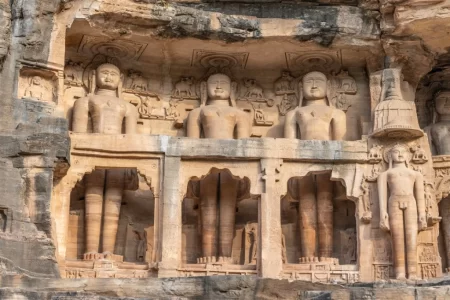
Exploring the Rich Legacy of Jain Heritage
Jainism, one of India’s oldest religions, has a rich cultural, spiritual, and architectural past that still influences society today. The religion, founded on principles of non-violence (Ahimsa), truth (Satya), and asceticism, has left an indelible mark on the subcontinent’s cultural landscape. The Jain Heritage is a testament to this ancient tradition, with its temples, scriptures, and art playing a crucial role in preserving its timeless teachings.
Architectural Marvels of Jainism
- Jain temples, known for their intricate carvings and awe-inspiring designs, reflect the profound spiritual beliefs of the Jain community. Temples such as those at Dilwara in Mount Abu, Ranakpur in Rajasthan, and Shravanabelagola in Karnataka are not only places of worship but also architectural masterpieces. These temples are constructed using white marble, which is often meticulously carved to depict scenes from Jain scriptures, gods, and celestial beings.
- The Dilwara Temples, for example, stand out for their sheer artistic beauty. Built between the 11th and 13th centuries, they showcase a level of craftsmanship rarely seen elsewhere. Every inch of the temple’s walls and ceilings is adorned with fine details, illustrating stories from Jain mythology and the life of Tirthankaras, the spiritual teachers in Jainism.
- Shravanabelagola is another iconic site of Jain heritage. The tall monolithic statue of Bahubali, one of the biggest free-standing monuments in the world, is housed there and is situated in Karnataka. This 57-foot-tall statue, carved out of a single granite rock, represents Bahubali’s deep meditation and renunciation of worldly desires. The Mahamastakabhisheka, a grand religious ceremony held once every 12 years at Shravanabelagola, draws thousands of devotees and visitors from around the globe.
Jain Art and Literature
- In addition to its architectural wonders, Jain heritage also includes a wealth of art and literature. Jain manuscripts are an integral part of the community’s cultural legacy, many of which are written in ancient languages such as Prakrit, Sanskrit, and Apabhramsha. These texts, often beautifully illustrated, contain spiritual teachings, historical records, and doctrinal explanations.
- The Kalpasutra, an ancient Jain text that narrates the life of Mahavira, the 24th Tirthankara, is one such manuscript that holds immense religious significance. Illustrated versions of the Kalpasutra, created by Jain monks and artists, often depict Mahavira’s life events with intricate miniature paintings. These manuscripts were historically commissioned by wealthy Jain patrons and have now become prized artifacts in museums worldwide.
- The Jain art tradition extends beyond manuscripts, encompassing sculptures, frescoes, and murals found in temples and caves. These works of art serve both aesthetic and devotional purposes, often portraying Jain deities, symbols, and mythological narratives.
The Enduring Impact of Jain Heritage
Today, Jain heritage continues to influence Indian society and beyond, with its teachings on non-violence, environmental conservation, and ethics resonating in contemporary discourse. Jainism’s emphasis on the interconnectedness of life and respect for all living beings has contributed significantly to global conversations on sustainable living and animal rights.
Conclusion
In preserving their ancient culture, Jains have ensured that their heritage remains a vibrant part of India’s spiritual and cultural landscape. Whether through the magnificence of its temples, the depth of its literature, or the beauty of its art, Jain heritage stands as a beacon of timeless wisdom and devotion.
